
REPORT
THE UPPER UTHUKELA CATCHMENT PARTNERSHIP
MULTI-STAKEHOLDER WORKSHOP
10 November 2022
At Okhahlamba LM Sports Centre, Golf Road, Bergville, KwaZulu-Natal
Prepared by:
Rebecka Henriksson
HenrikssonR@ukzn.ac.za

TABLE OF CONTENTS
1.INTRODUCTION AND BACKGROUND .....................................................................................................3
2.PURPOSE OF THE WORKSHOP ...............................................................................................................3
3.WORKSHOP PROGRAMME AND OUTCOMES ........................................................................................4
3.1 Participants and inclusivity ..................................................................................................................4
3.2 Introduction of the partnership and feedback on previous meetings ................................................5
3.3 Brief presentations: research and project updates .............................................................................6
3.4 SAEON and EFTEON .............................................................................................................................7
3.5 A consolidated vision for the catchment .............................................................................................8
3.6 Group activities ....................................................................................................................................9
4.Feedback from participants .................................................................................................................13
5.Ways forward and next engagement...................................................................................................13
APPENDIX 1: WORKSHOP PROGRAM ..........................................................................................................14
APPENDIX 2: WORKSHOP PARTICIPANTS ....................................................................................................15

3
1.INTRODUCTION AND BACKGROUND
The process towards establishing a strategic water source partnership (SWSP) in the Northern
Drakensberg was initiated in May 2021 when we held the first multi-stakeholder workshop in Bergville
for the SANBI Living Catchment Project (LCP), which aimed at convening stakeholderstowards ensuring
water security in the Upper uThukela. Since then there have been a number of meetings that different
stakeholders participated in (Figure 1), aimingat bringing a diversity of stakeholders together, enabling
knowledge sharing, developing a shared vision and encouraging collaboration towards establishing a
catchment partnership. Thus far, a total of 112 stakeholders have participated, representing over 60
organizations, groups and communities from policy and government, operators, financial actors, interest
and influential groups and users (see Figure 2 for stakeholder categorization).
Figure 1. Series of stakeholder engagements in the Upper uThukela Catchment Partnership
The Institute of Natural Resources (INR), the Centre for Water Resources Research (CWRR) at University
of KwaZulu-Natal (UKZN), and the Mahlathini Development Foundation (MDF) hosted the latest meeting
on the 10 November 2022 together with the Southern African Environmental Observation Network
(SAEON) and the Expanded Freshwater and Terrestrial Environmental Observation Network (EFTEON)
team, as their mandate is to bring stakeholders together around their research activities.
2.PURPOSE OF THE WORKSHOP
This workshop was building on the Adaptive Planning Process (APP) workshop on the 14 June 2022, with
the purpose to:
•Getting new and old stakeholders up to speed with the partnership process
•Consolidating the vision for the catchment
•Setting the objectives for the partnership – how can we work towards the vision
•Mapping of stakeholders and their activities, projects and information available for sharing

4
Figure 2. Categories of stakeholders related to Water, Land and People in the Upper uThukela Catchment,
adopted from the OECD Water Governance Indicator Framework.
3.WORKSHOP PROGRAMME AND OUTCOMES
3.1 Participants and inclusivity
The workshop was attended by 45 participants (24 women and 21 men), representing the local
communities, water committees, action groups, youth Eco Champs, representatives of the Amakhosi
areas AmaZizi, AmaNgwane and AmaSwazi; as well as ward councillors, and representatives from
Okhahlamba Local Municipality, SANBI, WildTrust, the Wilderness group, the Farmers No-till Club, the
Agricultural Research Council, Conservation Outcomes, Department of Forestry, Fisheries and the
Environment, KZN Department of Economy Development,Tourism & Environmental Affairs, Ezemvelo
KZN Wildlife, Maloti Drakensberg Transfrontier Project, Endangered Wildlife Trust, the South African
Environmental Observation Network (SAEON) and the Expanded Freshwater and Terrestrial
Environmental ObservationNetwork(EFTEON), University ofKwaZulu-Natal (UKZN), University of Free
State and Rhodes University (see Appendix 2 for list of participants).
The facilitation of the workshop was designed to create an inclusive environment for such diverse group
of participants, where all perceptions are respected and everybody’s voices are heard. All conversations
and presentations were translated betweenEnglish and isiZulu. Technical terms, scientific jargon and
culture-contextualspecifics were explained/translated in an approachable way to enable equal
participation and meaningfulco-learning.

5
3.2 Introduction of the partnership and feedback on previous meetings
The workshop started with an introduction of the process for establishing a catchment partnership and
an overview of previous stakeholdermeetings and outcomes. Theorganizing team presented a
framework and principles of stakeholder engagement adopted from the OECD (OECD Stakeholder
engagement for inclusive water governance) by first describing different levels of stakeholder
engagement (Figure 3) as well as the OECD principles of stakeholder engagement, how to follow them
and what we are focusing on for this partnership process (Figure 4).
Figure 3. Levels of stakeholder engagement adopted from the OECD Stakeholder engagement for inclusive
water governance.
Figure 4. The OECD principles of stakeholder engagement, how to follow them and what we are currently
focusing on for this partnership process.

6
The organizers proceeded to revisit the outcomes of the Adaptive Planning Process (APP) workshop held
on the 14 June 2022 and the online catch-up meeting on 29 September 2022. The APP included the steps
Current concerns, Shared values and a Joint vision to be developed in groups. The vision statements were
further discussed later in the program and are presented in section 3.5 in this report.
3.3 Brief presentations: research and project updates
Knowledge sharing is an important aspect of the partnershipand forms a basis of collaboration and
networking among participants. This workshop saw a few brief presentations from research and other
projects which are taking place in the catchment (Figure 5).
Bawinile Mtolo and Brigid Letty presented work on spring protection in KwaMagaba, funded by SANBI
LCP/WRC. The spring was unprotected and the users had submerged two halfdrums into the wetland,
over the eyes of the spring to allow them tocollect water. Based on discussions with the local households
and an agricultural engineer, a covered concrete chamber with a lid was built to replace the metal drums
and the area was fenced to reduce trampling and pollution from livestock.
Brigid and Senzo Dunywa presented updates on INR’s restoration work funded by WWF/PepsiCo in
AmaSwazi (in partnership with WildTrust) and in Stulwane (in partnershipwith Mahlathini). The
restoration work includes the use of waste from wattle clearing to construct brushpacks that are placed
on the contour to slow down run-off and capture sediment. The captured sediment allows for effective
revegetation of the slopes and gullies that are being revegetated.
Erna Kruger presented Mahlathini’s work on community based climate change adaptation (CbCCA) in
Costone, Ezibomvini and Vimbukhalo. Decades of work in co-developing climate resilience activities in
small-holder farming systems across 18 villages, have resulted in a diverse set of solutions including
conservation agriculture, livestock integration, intensive homestead food production,soil and water
conservation and community owned local water access.
Rebecka Henriksson presented WRC funded researchon Co-learning for sustainable land and water
management in Ezibomvini and Costone. This transdisciplinary project includes research on rainfall and
water quantity, ecosystem health and functioning, mapping of land use, ecosystem services and
livelihood as well as decisions around community resources. Co-learning workshops have focused on land
and water use, dependency and management practices and options.
These presentations sparked a conversation about the importance on creating partnerships with
community members in order to hear their interests and priorities and for communities to take
responsibility so that projects can carry on beyond the timeframe of the project.Participants expressed
appreciation learning from the work done through these presentations and suggestions were made to
learn from and share with communities from other areas and catchments.

7
Figure 5. Projects in the Upper uThukela catchment presented by partners and collaborators within the
partnership.
3.4 SAEON and EFTEON
Kathleen Smart introduced the NRF-funded Expanded Freshwater and Terrestrial Environmental
Observation Network (EFTEON). In the Northern Drakensberg, the EFTEON landscape is being hosted by
the SAEON Grasslands Node, who works in Cathedral Peak. The Northern Drakensberg Landscape is one
of six EFTEON landscapes spread across South Africa where long-term monitoring will take place,
including weather,social data, biodiversity data, mapping soils anderosion, pollution andthe flow of
nutrients as they move through the ecosystem (soils, plants, rivers). This in situdata will be combined
with remotely sensed data and used in models, and it all provides a platform for training students and
engaging with citizen science. EFTEON and SAEON want to be long-term interdisciplinary partners in the
Upper uThukela Catchment partnership. EFTEON will work across the landscape, in the communities. The
information will be important for the community, the partnership, but also to raise the voice of the
“global south” in international discussions and negotiations.
Questions were raised about the relevance of the long term monitoring to the communities and how the
information will be shared. It was explained that this initiativeis collaborative and how the monitoring
should look like and how the information will be sharedwill be co-designed with the communities.
EFTEON will purchase, install and maintain the equipment, and the data collected is for the community.
All the data is open source, available to everyone, and where possible, available in real time.EFTEON
technicians will collaborated with clinics, schools, local NGOs and community actiongroups to be engaged
in surveys, data collection, knowledge sharing and education camps and assure that the information
reach the communities in the forms and ways that are useful for them.
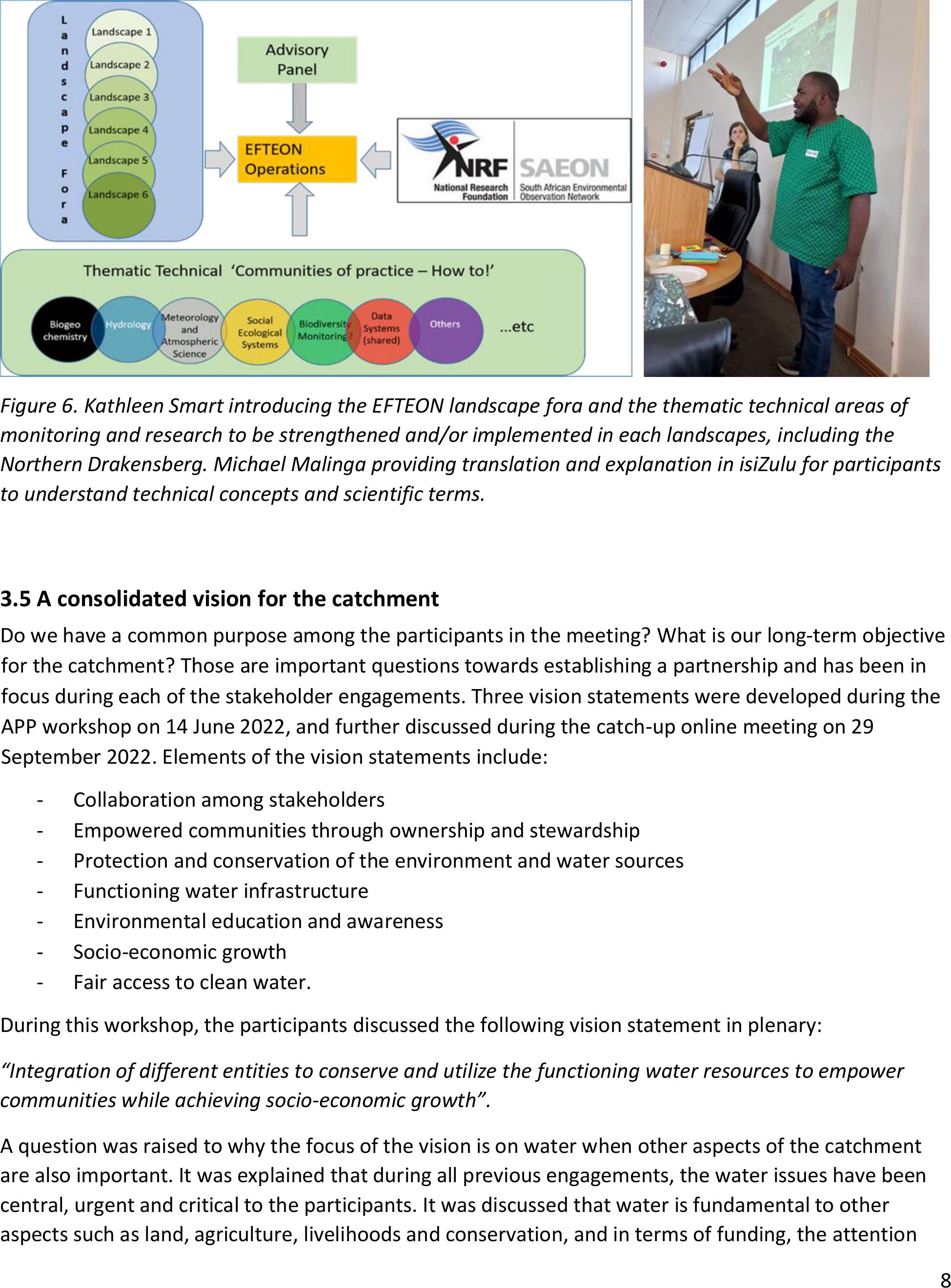
8
Figure 6. Kathleen Smart introducing the EFTEON landscape fora and the thematic technical areas of
monitoring and research to be strengthened and/or implemented in each landscapes, including the
Northern Drakensberg. Michael Malinga providing translation and explanation in isiZulu for participants
to understand technical concepts and scientific terms.
3.5 A consolidated vision for the catchment
Do we have a common purpose among the participants in the meeting? What is our long-term objective
for the catchment? Those are important questions towards establishing a partnership and has been in
focus during each of the stakeholder engagements. Three vision statements were developed during the
APP workshop on 14 June 2022, and further discussed during the catch-up online meeting on 29
September 2022. Elements of the vision statements include:
-Collaboration among stakeholders
-Empowered communities through ownership and stewardship
-Protection and conservation of the environment and water sources
-Functioning water infrastructure
-Environmental education and awareness
-Socio-economic growth
-Fair access to clean water.
During this workshop, the participants discussed the following vision statement in plenary:
“Integration of different entities to conserve and utilize the functioning water resources to empower
communities while achieving socio-economic growth”.
A question was raised to why the focus of the vision is on water when other aspects of the catchment
are also important. It was explained that during all previous engagements, the water issues have been
central, urgent and critical to the participants. It was discussed that water is fundamental to other
aspects such as land, agriculture, livelihoods and conservation, and in terms of funding, the attention
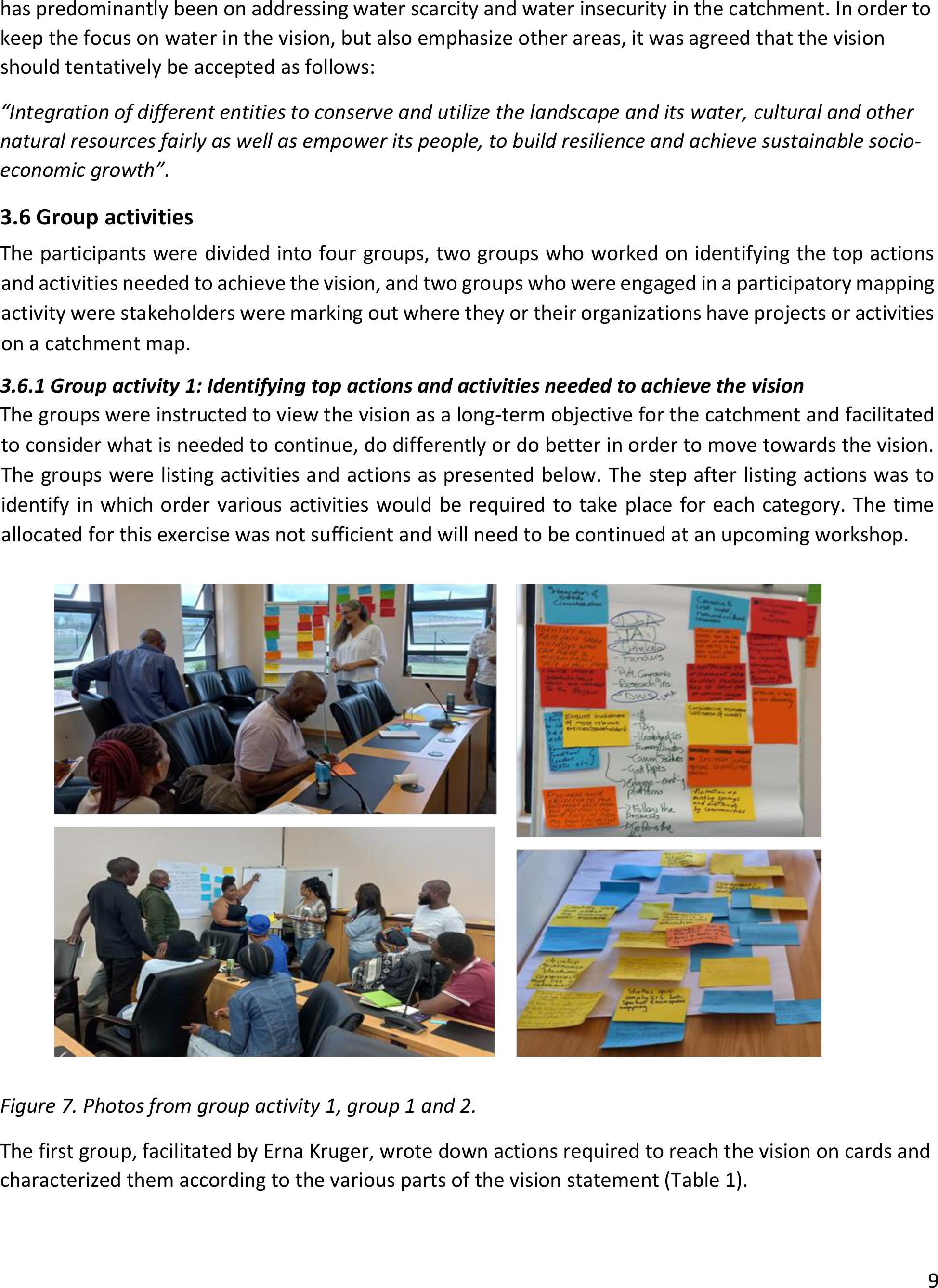
9
has predominantly been on addressing water scarcity and water insecurity in the catchment. In order to
keep the focus on water in the vision, but also emphasize other areas, it was agreed that the vision
should tentatively be accepted as follows:
“Integration of different entities to conserve and utilize the landscape and its water, cultural and other
natural resources fairly as well as empower its people, to build resilience and achieve sustainable socio-
economic growth”.
3.6 Group activities
The participants were divided into four groups, two groups who worked on identifying the top actions
and activities needed to achieve the vision, and two groups who were engaged in a participatory mapping
activity were stakeholders were marking out where they or their organizations have projects or activities
on a catchment map.
3.6.1 Group activity 1: Identifying top actions and activities needed to achieve the vision
The groups were instructed to view the vision as a long-term objective for the catchment and facilitated
to consider what is needed to continue, do differently or do better in order to move towards the vision.
The groups were listing activities and actions as presented below. The step after listing actions was to
identify in whichorder various activities would berequired to takeplace for each category. The time
allocated for this exercise was not sufficient and will need to be continued at an upcoming workshop.
Figure 7. Photos from group activity 1, group 1 and 2.
The first group, facilitated by Erna Kruger, wrote down actions required to reach the vision on cards and
characterized them according to the various parts of the vision statement (Table 1).
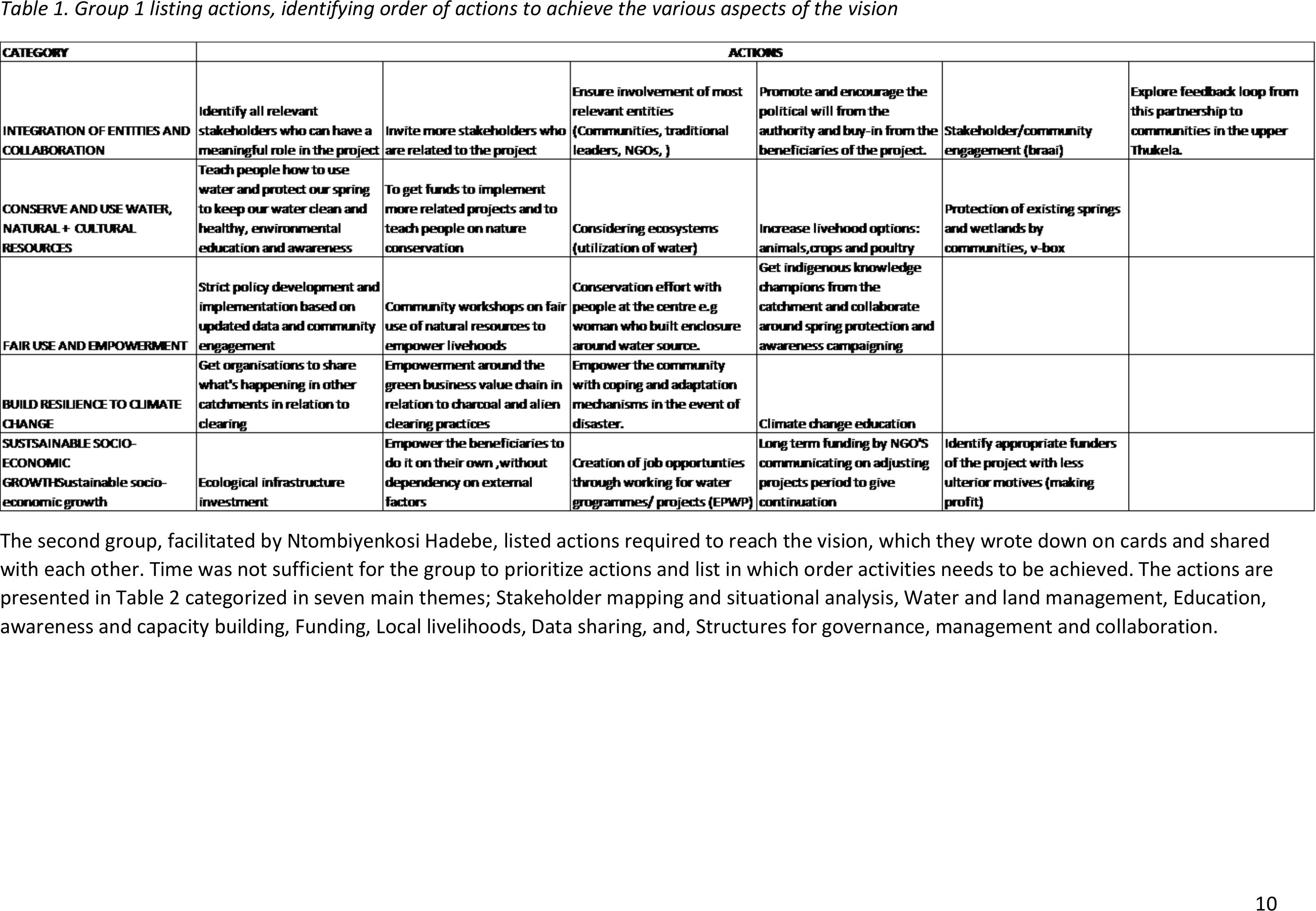
10
Table 1. Group 1 listing actions, identifying order of actions to achieve the various aspects of the vision
The second group, facilitated by Ntombiyenkosi Hadebe, listed actions required to reach the vision, which they wrote down on cards and shared
with each other. Time was not sufficient for the group to prioritize actions and list in which order activities needs to be achieved. The actions are
presented in Table 2 categorized in seven main themes; Stakeholder mapping and situational analysis, Water and land management, Education,
awareness and capacity building, Funding, Local livelihoods, Data sharing, and, Structures for governance, management and collaboration.

11
Table 2. Group 2 listing actions required to achieve the vision
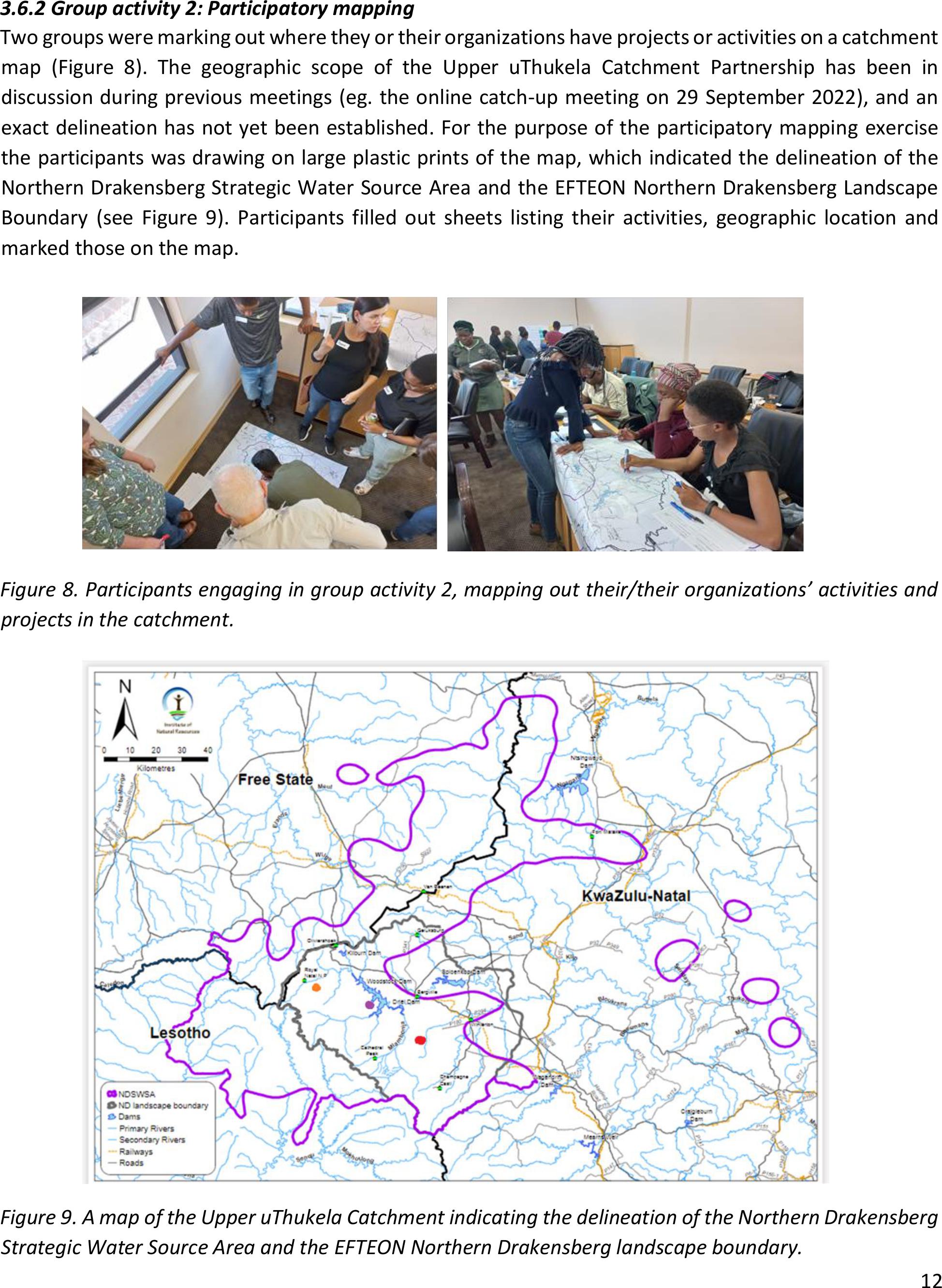
12
3.6.2 Group activity 2: Participatory mapping
Two groups were marking out where they or their organizations have projects or activities on a catchment
map (Figure 8). The geographic scope of the Upper uThukela Catchment Partnership has been in
discussion during previous meetings (eg. the online catch-up meeting on 29 September 2022), and an
exact delineation has not yet been established. For the purpose of the participatory mapping exercise
the participants was drawing on large plastic prints of the map, which indicated the delineation of the
Northern Drakensberg Strategic Water Source Area and the EFTEON NorthernDrakensberg Landscape
Boundary (see Figure9).Participants filled out sheets listing their activities, geographic location and
marked those on the map.
Figure 8. Participants engaging in group activity 2, mapping out their/their organizations’ activities and
projects in the catchment.
Figure 9. Amap of the Upper uThukela Catchment indicating the delineation of the Northern Drakensberg
Strategic Water Source Area and the EFTEON Northern Drakensberg landscape boundary.
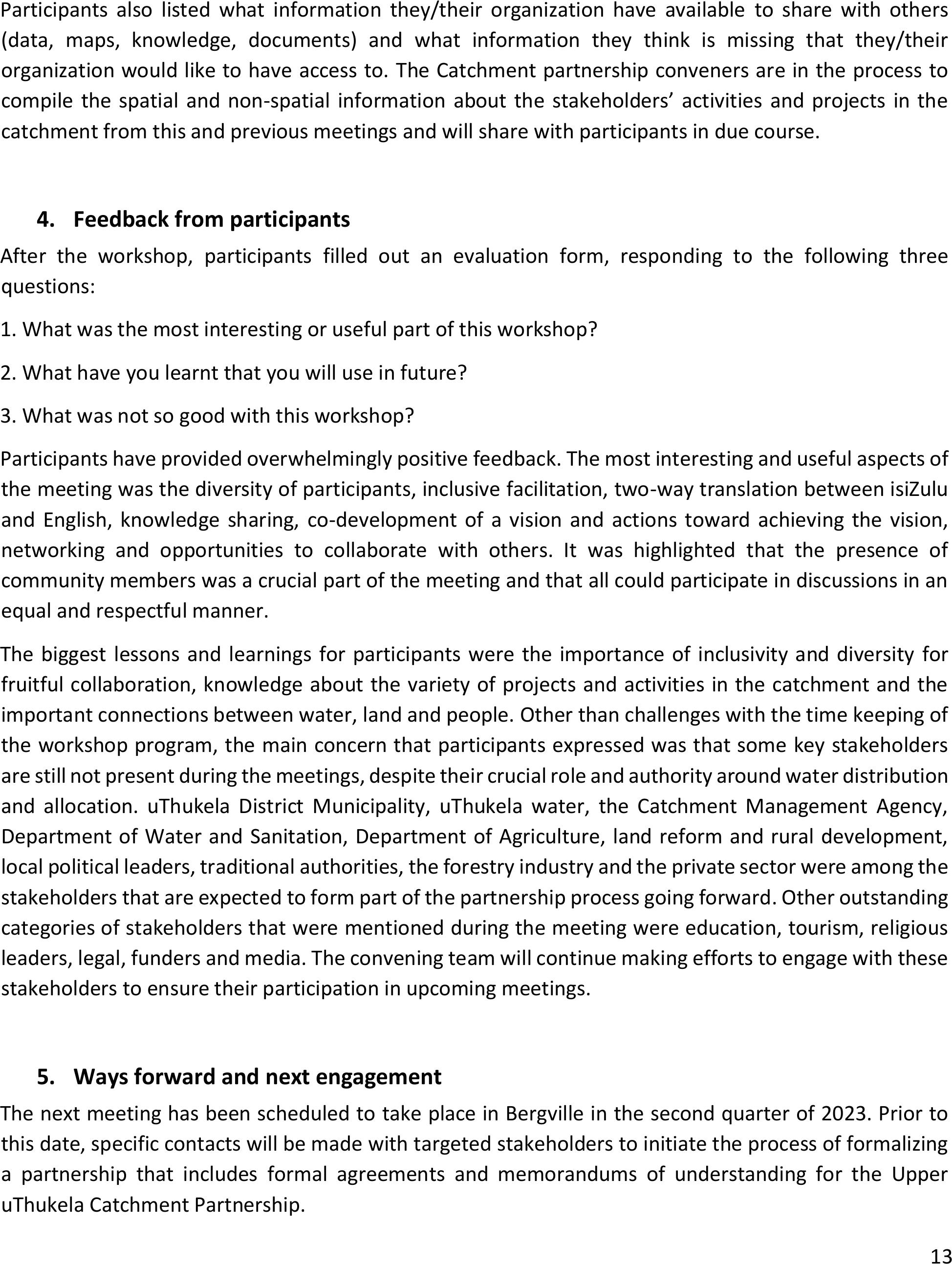
13
Participants also listed what information they/their organization have available to share with others
(data, maps, knowledge, documents) and what information they think is missing that they/their
organization would like to haveaccess to.The Catchment partnership conveners are inthe processto
compile the spatial and non-spatial information about the stakeholders’ activities and projects in the
catchment from this and previous meetings and will share with participants in due course.
4.Feedback from participants
After the workshop, participants filled out an evaluation form, responding to the following three
questions:
1. What was the most interesting or useful part of this workshop?
2. What have you learnt that you will use in future?
3. What was not so good with this workshop?
Participants have provided overwhelmingly positive feedback. The most interesting and useful aspects of
the meeting was the diversity of participants, inclusive facilitation, two-way translation between isiZulu
and English, knowledge sharing, co-development of a vision and actions toward achieving the vision,
networking and opportunities to collaborate with others. It was highlighted that the presence of
community members was a crucial part of the meeting and that all could participate in discussions in an
equal and respectful manner.
The biggest lessons and learnings for participants were the importance of inclusivity and diversity for
fruitful collaboration, knowledge about the variety of projects and activities in the catchment andthe
important connections between water, land and people. Other than challenges with the time keeping of
the workshop program, the main concern that participants expressed was that some key stakeholders
are still not present during the meetings, despite their crucial role and authority around water distribution
and allocation. uThukela District Municipality, uThukela water, the Catchment Management Agency,
Department of Water and Sanitation, Department of Agriculture, land reform and rural development,
local political leaders, traditional authorities, the forestry industry and the private sector were among the
stakeholders that are expected to form part of the partnership process going forward. Other outstanding
categories of stakeholders that were mentioned during the meeting were education, tourism, religious
leaders, legal, funders and media. The convening team will continue making efforts to engage with these
stakeholders to ensure their participation in upcoming meetings.
5.Ways forward and next engagement
The next meeting has been scheduled to take place in Bergville inthe second quarter of 2023. Prior to
this date, specific contacts will be made with targeted stakeholders to initiate the process of formalizing
a partnership that includes formal agreements and memorandums of understanding for the Upper
uThukela Catchment Partnership.
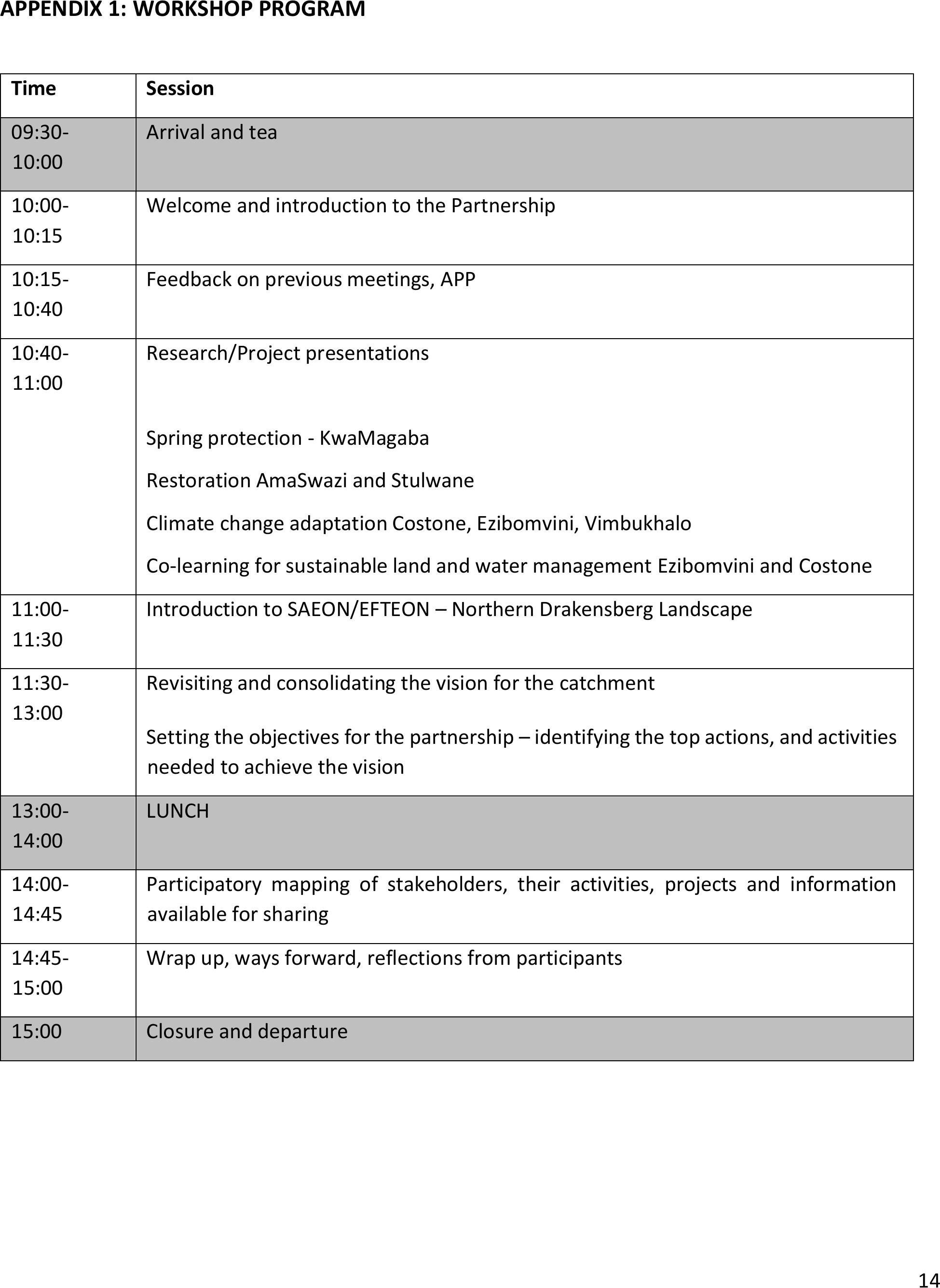
14
APPENDIX 1: WORKSHOP PROGRAM
Time
Session
09:30-
10:00
Arrival and tea
10:00-
10:15
Welcome and introduction to the Partnership
10:15-
10:40
Feedback on previous meetings, APP
10:40-
11:00
Research/Project presentations
Spring protection - KwaMagaba
Restoration AmaSwazi and Stulwane
Climate change adaptation Costone, Ezibomvini, Vimbukhalo
Co-learning for sustainable land and water management Ezibomvini and Costone
11:00-
11:30
Introduction to SAEON/EFTEON – Northern Drakensberg Landscape
11:30-
13:00
Revisiting and consolidating the vision for the catchment
Setting the objectives for the partnership –identifying the top actions, and activities
needed to achieve the vision
13:00-
14:00
LUNCH
14:00-
14:45
Participatory mapping of stakeholders, their activities, projects and information
available for sharing
14:45-
15:00
Wrap up, ways forward, reflections from participants
15:00
Closure and departure

15
APPENDIX 2: WORKSHOP PARTICIPANTS
Organization
Representative
Organization
Representative
Agricultural Research Council
Alanna Rebelo
Ezemvelo KZN Wildlife
Benedict Nene
Agricultural Research Council
Liam Cogill
Ezemvelo KZN Wildlife
Mark Robertson
Agricultural Research Council
Thandeka Skosana
Ezemvelo KZN Wildlife
Siphiwe Khoza
AmaNgwane - Vimbukhalo -
new water committe
Nikeliwe Ngubane
Ezemvelo KZN Wildlife
Zandile Mtambo
Amangwane action group -
Mnweni
Khumbulani Ndaba
Institute of Natural Resources
Brigid Letty
AmaNgwane Ecochamp
Stulwane/Ezibomvini
Boniswa Hlongwane
Mahlathini Development
Foundation
Erna Kruger
AmaNgwane Ecochamp
Stulwane/Ezibomvini
Silindile Mpinga
Mahlathini Development
Foundation
Hlengiwe Hlongwane
Amangwane Environmental
Monitors
Mzokhona Hlongwane
Mahlathini Development
Foundation
Mazwi Dlamini
AmaNgwane Stulwane -
Water committe
Nothile Zondi
Mahlathini Development
Foundation
Michael Malinga
Amangwane Traditional
Council
Thomson Zwane
No-till club
Anthony D Muirneay
Amangwane Ward Councillor
Ward 14 (Stulwane)
Thembinkosi Jeffrey
Dladla
Okhahlamba Local
Municipality
Nkosingiphile Malinga
AmaSwazi Livestock
association Emakhwelela
Bongumusa Khoza
Rhodes University/ LCP
student
Philisa Dunyana
AmaSwazi Livestock
association KwaMlotha
Robert Hlophe
SAEON
Sachin Doarsamy
AmaZizi Okhombe
Nkosithandile Ndlovu
SAEON/EFTEON
Kathleen Smart
AmaZizi Ward Committee
Ntombile Radebe
SANBI
Dan'sile Cindi
AmaZizi Wilderness group
Bawinile Mtolo
SANBI
Hulisani Magada
Conservation Outcomes
Steve McKean
UKZN -CWRR
Ntombiyenkosi
Hadebe
DFFE - Dept Forestry,
Fisheries and the
Environment
Sappi Buthelezi
UKZN -CWRR
Rebecka Henriksson
EDTEA - KZN Dept Econ Dvmt,
Tourism & Env Affairs
Bheki Gwala
University of Free State
Aliza Le Roux
EKZNW - MDTP
Joyce Loza
University of Free State
Neo Mathinya
EKZNW Cathedral peak
Selby Mkhize
Wildtrust
Mbongiseni Shongwe
Endangered Wildlife Trust
Samson Phakathi
Wildtrust
Kirsten Oliver
Wildtrust
Senzo Dunywa